
INTERVIEW
14
At a glance: OSHA’s Fall
Prevention Campaign
PLAN ahead to get the job done safely
When working from heights, such as ladders, scaffolds and roofs, employers must plan projects to
ensure that the job is done safely. Begin by deciding how the job will be done, what tasks will be
involved, and what safety equipment may be needed to complete each task.
When estimating the cost of a job, employers should include safety equipment, and plan to have
all the necessary equipment and tools available at the construction site. For example, on a roofing
job, think about all of the different fall hazards, such as holes or skylights and leading edges, then
plan and select fall protection suitable to that work, such as personal fall arrest systems (PFAS).
PROVIDE the right equipment
Workers who are 6 feet or more above lower levels are at risk for serious injury or death if
they should fall. To protect these workers, employers must provide fall protection and the right
equipment for the job, including the right kinds of ladders, scaffolds and safety gear.
Different ladders and scaffolds are appropriate for different jobs. Always provide workers with the
kind they need to get the job done safely. For roof work, there are many ways to prevent falls. If
workers use personal fall arrest systems (PFAS), provide a harness for each worker who needs to
tie off to the anchor. Make sure the PFAS fits, and regularly inspect all fall protection equipment to
ensure it’s still in good condition and safe to use.
TRAIN everyone to use
the equipment safely
Falls can be prevented when workers
understand proper set-up and safe use of
equipment, so they need training on the
specific equipment they will use to complete
the job. Employers must train workers in
hazard recognition and in the care and safe use
ladders, scaffolds, fall protection systems and
other equipment they’ll be using on the job.
OSHA has provided numerous materials
and resources that employers can use during
toolbox talks to train workers on safe practices
to avoid falls in construction. Falls from
ladders, scaffolds and roofs can be prevented
and lives can be saved through three simple
steps: Plan, Provide and Train.
ACCESS, LIFT & HANDLERS
SEPTEMBER-OCTOBER 2013
given out around 60,000 pieces of literature to
different groups, and that’s just off of the OSHA
formal materials. We really don’t have any idea
of how many other websites have taken our
materials and posted them or distributed them
to other people.”
Through community events, seminars, state
planning partners, Maddux says the campaign
has had a huge impact “in terms of the number
of people who have gotten involved.”
“The response has been phenomenal,” he
says.
In order to get word out to the far reaches of
the U.S., OSHA has worked with its local field
offices and compliance assistances specialists.
Together, a handful of ideas and promotions
have sprung forth, but Maddux is realistic when
asked how he plans to educate everyone.
“That is the biggest challenge that we have,”
he says. “This is a difficult, generalized, diffused
audience to try and reach. One of the qualities of
this campaign is that it’s a lot of different people
doing a lot of different things.”
One approach is OSHA’s “Stand-Down on Fall
Prevention.” In Chicago, Atlanta and New York
City, employers ceased work for 30 minutes
to provide focused training on how falls can
be prevented with the right safety equipment.
OSHA’s Chicago area offices partnered with
the Builders Association, Construction Safety
Council, the Chicago Area Laborers-Employers
Cooperation and Education Trust, construction
contractors and other safety and health
organizations to sponsor a safety stand down
on June 12. At 70 construction sites across the
Chicago area, 1,500 workers ceased work for
about 30 minutes. In New York and New Jersey,
more than 120 stand downs were held and
more than 4,000 workers paused for training.
OSHA plans to roll out stand-downs in Kansas,
Missouri and Nebraska soon.
OSHA has also taken to public transportation
to get the word out. Maddux says OSHA
targets areas where workers depend on public
transportation to get to and from the jobsite.
“We’ve had bus poster campaigns in Washinton
D.C. and we’re kicking off another one in
Dallas,” he says.
The Administration also depends on its
compliance assistance specialists to identify
local opportunities such as civic group meetings,
religious consortiums and regional fairs where
booths can be set up to inform the public about
what OSHA is doing.
All of OSHA’s Fall Prevention Campaign
materials have been translated into Spanish for
multi-language jobsites. Maddux says they have
also translated sheets into Russian and Polish,
depending on the area. “New York City has a
large Russian-speaking construction population
and Boston has a large Portuguese-speaking
construction population, so our field tells us
what they need.”
The Administration has also made many
materials available for smart phones or tablets,
such as ladder, scaffold and roof ‘toolbox talks.
“We put out ‘toolbox talks,’ where at the
beginning of the day, the supervisor brings all
the workers together on the site and they talk
about the work going to be done for the day and
how to it safely,” Maddux says.
Because, at the end of the day, falls
from height resulting in death or injury are
preventable, Maddux says.
“There are so many workers that are being
killed on the job,” he says. “Through this
program, there are so many solutions that are
out there to solve the problem. I really feel
strongly that this is a great campaign that goes
at the largest safety problem in the construction
area and it really has impact to save lives.”
To learn more about OSHA’s Fall Prevention
Campaign, see our box story or visit
.
gov/stopfalls.
■
An example of OSHA’s printed ad
materials geared toward educating
workers on fall prevention.
Source: OSHA


